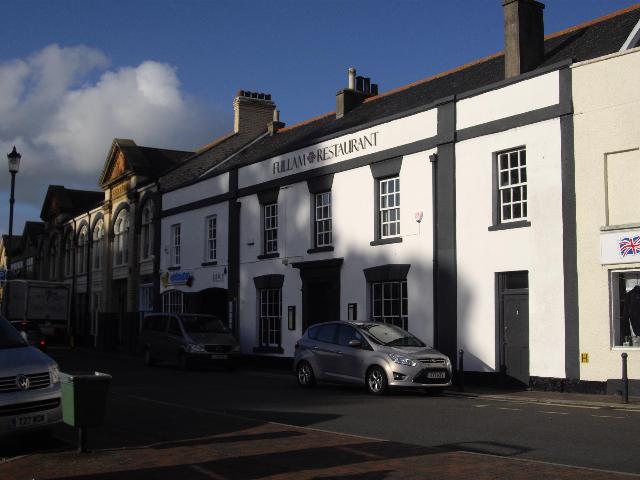» Main Index

» Search This Site

» Submit Update

» Contact Us


|
|

|
Home > Devon >
Barnstaple > Golden Fleece
Golden Fleece
 |
|
Picture source: Clive Schneidau |
|
|
|
|
The Golden Fleece was situated on Tuly Street.
This grade-II listed pub closed c1990 and is now used as a restaurant. |
|
|
I thought you might be interested in a
reference I came across in the Navy Board Minutes which are held at the
National Archive at Kew. It concerns an incident when a press gang from His
Majesty's Brigantine the Post Boy, met up at the Golden Fleece in
Barnstable;
Captain John Carleton of the Post Boy met up with a local Justice, Captain
Kinnick & Lieutenant Hyatt for dinner there on Friday the 5th of March 1697.
On the Saturday the Captains together with 15 of Lieutenant Hyatts soldiers
and 13 or 14 of the Post Boys men set off for Conne{?}. To avoid any
accidents, Captain Carleton cautioned the men only to load their weapons
with powder, they all having muskets. On entering the town of Conne{?} they
met with a Captain Stocker, whose crew were the intended target for the
press gang. Captain Stocker drew up his men in their way, and declared if
any should run from him he would run them through, he having drawn his
sword. Carleton tried to reason with him, urging him to let the men join the
navy as volunteers, only to receive a blow from Stocker (presumably not with
the blade of the sword). At this, Carleton drew his sword and urged his men
to secure as many seamen for His Majesty's service as they could. In the
ensuing mêlée, Stockers men attempted to grab the muskets, one or two of
which were discharged, and Captain Stocker was shot, (I presume fatally).
Source
Copy of a letter from Captain John Carleton, Commander of the Postboy
brigantine, dated from the Golden Fleece at Barnstable, the 7th of March
1696/7 Admiralty Secretary, letters from the Navy Board, Adm 1/3580, p 971 &
975 |
|
Patrick Gosset (August 2017) |
|
|
|
|
|
|
Listed
building details: |
Public house. Early or mid C19, but
incorporating a late C16 or early C17 rear wing. Rendered, solid walls,
probably of stone or brick; C17 wing, patchily covered with roughcast,
appears to be of stone rubble with an upper storey of cob except for the
rear (E) gable-wall which is of exposed red brick in English bond. Tarred,
slated roof; C17 wing covered with corrugated asbestos. 3 rendered chimneys,
asymmetrically placed on main range. Chimney in rear gable of C17 wing, with
rebuilt shaft. Double-depth plan with central passage along its spine.
Carriageway through left-hand end of building, leading to stable yard at
rear. C17 wing has 1 small room on each floor. 2 storeys. Front is 6-window
range, divided into 3 unequal bays by pilaster-strips; 3 windows in centre,
2 to left and
one to right. Centre bay has doorway flanked by windows, the former with
moulded architrave and flat moulded hood on consoles; windows have
rusticated cement architraves with vermiculated key blocks, the openings
(now boarded) originally with triple sashes. The 3 upper-storey windows have
slightly raised cement arches, originally rusticated; 6-pane sashes.
Left-hand bay has segmental arches carriage-gate with double doors to right;
similar blind or blocked archway to its left, with pier between. 2 windows
with plain heads and 6-pane sashes in upper storey. Right-hand bay has
4-panelled door with oblong fanlight in ground storey and 6-paned sash
window above. Neither opening is decorated in any way; probably this was the
original arrangement, since a photograph of 1916 shows that only the
openings in the middle bay were then decorated. In 1916 the right-hand
doorway was a window with 6-paned sashes. The front is finished with a plain
band and parapet with coping; the pilaster-strips are continued on the
parapet. Rear wall has several barred sashes. Right-hand side wall of C17
wing, visible from rear of No.17, has sash window in ground storey with
blocked doorway to right. In the upper storey a 2-light wood-mullioned
window; mullions moulded, the right-hand light filled with diamond shaped
panes of old green glass in lead cames. Similar glass from the other light
may be lying loose inside.
Interior: has nothing of special interest. C17 wing is accessible only on
ground floor, but is likely to have early fireplaces and possibly other
features under the plaster. Although the C17 building is only a fragment, it
has considerable quality, and provides rare evidence of house-building in
cob in the old town centre.
Historical Note: The Golden Fleece was built by the Barnstaple Bridge Trust
and sold by them in 1922. For an early engraving of it, see Harper's Albums,
Vol.5, p49, in the North Devon Athenaeum. The rear wing may originally have
been part of No.17 (not included). |
|
|
|
Do you have any anecdotes, historical information, updates or photos of this pub? Become a contributor by submitting them here. Like this site? Follow us on

|
|
Contacts |
|
Were you a customer, publican or member of staff
at this pub? Display your email contact details on this page by adding them here and let past regulars get in touch with you. |
| Name |
Dates |
Comments |
|
Dr Patrick Oates |
1970-1978 |
In the 1970's, Patrick Horgan was
the marvellous Landlord of this Pub. I was an Archaeologist working many
sites & Patrick supplied us with a Hot Bath for 6 pence, and hot pasties
after a day's toil. An educated man of wit & humour along with his wife
Cynthia, he kept the perfect Pub. Staying open long after 'closing
time', he'd Retire to bed & leave the bar, trusting our honesty It was
NEVER abused, and we locked up 'Last man out'. |
|
|